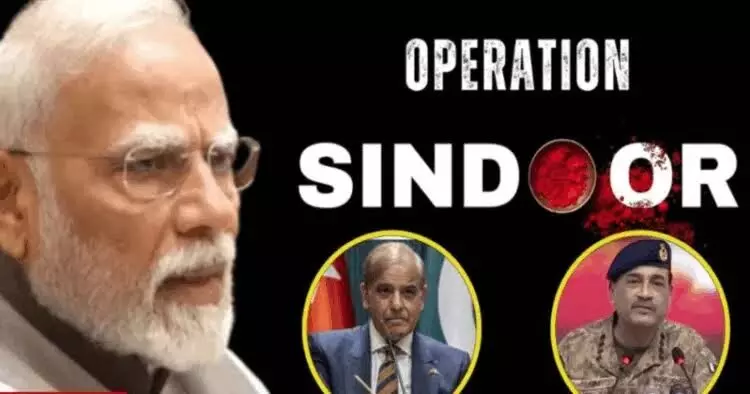A New Red Line: The Strategic and Diplomatic Implications of India’s New Counter terror Doctrine

India’s declaration that “any act of terror would be considered as an act of war” marks a profound shift in its strategic doctrine. For decades, India has operated under significant restraint in the face of cross-border terrorism, especially from Pakistan-backed non-state actors. But this new pronouncement signals a hardening of resolve and the drawing of a new red line in the subcontinent’s volatile security architecture.
The statement is not just rhetoric—it is a declaration with far-reaching consequences, both domestically and internationally. It upends the previous policy of measured retaliation and diplomatic protest, replacing it with the threat of full-scale military escalation. The implications span the realms of deterrence, regional stability, diplomacy, and India’s global positioning.
The Logic of Deterrence: Changing the Cost Equation
The primary objective of declaring terror acts as acts of war is to alter the cost-benefit calculus for those who sponsor or tolerate terrorism. For years, the Indian establishment has struggled with the “threshold paradox”: terrorist attacks, though devastating, remained below the threshold of conventional warfare, allowing perpetrators to escape accountability under the pretext of plausible deniability. The 2001 Parliament attack, the 2008 Mumbai attacks, the 2016 Uri attack—all led to limited retaliation or diplomatic fallout, but no strategic shift in the status quo.
By elevating terrorism to the level of casus belli, India is warning its adversaries: the next such attack could invite a military response not just against terrorist camps, but against state assets, infrastructure, or military targets. It is an attempt to raise the stakes—to make the price of proxy war prohibitively high.
This posture borrows from the doctrine of “massive retaliation” during the Cold War: deterring small-scale aggression by threatening disproportionate response. Whether this will succeed depends on credibility, consistency, and the readiness to follow through.
Strategic Risks: Escalation and Miscalculation
While this doctrine may bolster deterrence in theory, it carries significant risks. Chief among them is the potential for rapid escalation. In the subcontinent—home to two nuclear powers with a long history of conflict—even limited military engagement carries the risk of spiraling into a full-blown war. The Balakot airstrike in 2019, in response to the Pulwama attack, was a calibrated attempt to demonstrate resolve while avoiding escalation. But it also exposed how thin the line is between strategic signaling and outright conflict.
If India now treats every significant terror attack as grounds for war, it narrows its room for maneuver. Diplomatic engagement, economic sanctions, and covert operations—traditional tools of statecraft—may be sidelined in favour of overt military options. This reduces flexibility and increases the chances of miscalculation, particularly if a future attack occurs under ambiguous circumstances.
Diplomatic Fallout and Global Perception
India’s new position will also reshape its diplomatic relationships. On one hand, it may find sympathy and support from nations facing similar threats—Israel, the United States, and France have all espoused doctrines that reserve the right to use military force against terrorism. On the other hand, this approach may be viewed with alarm in global capitals concerned with regional stability.
India will need to work hard to ensure its doctrine is not perceived as belligerence, but as a legitimate and necessary assertion of sovereignty. That will require proactive diplomacy—articulating the rationale to allies, assuring the international community of its commitment to responsible conduct, and avoiding actions that can be construed as disproportionate or reckless.
At the United Nations and other multilateral forums, India will also face greater scrutiny. Calls for stronger evidence in the aftermath of attacks, pressure to “prove” state complicity, and resistance to unilateral action may increase. India’s longstanding push for a Comprehensive Convention on International Terrorism (CCIT) gains greater urgency in this context—it is now not just a legal ambition, but a strategic imperative.
Internal Security and Political Dynamics
The new doctrine also has internal implications. It raises the political stakes of counterterrorism. If the government fails to respond militarily to a future attack, it risks being seen as weak or inconsistent. Conversely, premature or poorly calibrated responses could trigger international backlash or domestic unease.
This creates a high-pressure environment for decision-makers, especially in the immediate aftermath of a terror incident. Intelligence agencies will face increased scrutiny to rapidly and credibly attribute attacks, while the armed forces may be tasked with executing swift responses in politically charged environments.
It also raises concerns about the possibility of false-flag operations or provocations aimed at manipulating India’s red lines. An adversary—or even a rogue actor—may attempt to spark conflict by staging an attack designed to appear as cross-border terrorism. In such scenarios, the burden on India’s intelligence and forensic capabilities will be immense.
A Doctrine Still in Formation
Despite its strong language, the new doctrine remains declaratory. Its contours—what qualifies as “an act of terror,” how attribution will be established, what level of response is envisioned—are not yet formally articulated. This ambiguity may serve as a strategic advantage, allowing policymakers flexibility. But it also creates uncertainty, which can be dangerous in times of crisis.
To operationalize this doctrine responsibly, India must develop a clear playbook: a framework for intelligence validation, response thresholds, escalation control, and diplomatic communication. Without such institutional clarity, the doctrine risks becoming a political slogan rather than a strategic policy.
India has drawn a red line. Whether it deters future attacks or invites new provocations will depend on its implementation. The statement that “any act of terror will be considered an act of war” is not just a warning to adversaries—it is a test of India’s own strategic maturity.
As a rising power, India must balance resolve with restraint, deterrence with diplomacy, and rhetoric with readiness. It must build coalitions, invest in intelligence, and strengthen homeland security. It must also be prepared for the long game—where deterrence is measured not in days or headlines, but in the slow, steady reduction of threats through a mix of military capability, political clarity, and diplomatic engagement.
History will judge whether this shift in doctrine was a moment of strategic clarity—or a trigger for new instability. The burden of that judgment rests on how India navigates the next crisis.
